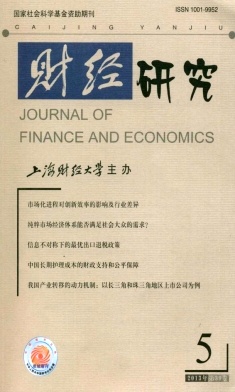组织冗余与我国民营上市企业风险投资:创始人控制的调节作用
财经研究 2013 年 第 39 卷第 05 期, 页码:63 - 73
摘要
参考文献
摘要
组织冗余对风险投资活动的作用机制目前尚不明晰,有必要结合具体情境进行讨论。文章利用我国147家民营高科技上市公司2008-2010年数据,考察了组织冗余与民营企业风险投资活动之间的关系以及创始人控制对两者关系的调节作用。研究发现,组织冗余与民营上市公司风险投资活动之间呈"倒U形"关系,创始人及其家族控制显著促进了民营企业在风险投资活动上的冗余资源配置。文章研究结论表明,冗余资源对民营企业风险投资活动来说是一把"双刃剑",创始人及其家族对民营企业的心理所有权发挥了重要作用,使企业战略决策更具有长期导向性。
[1]陈凌等.制度与能力:中国民营企业20年成长的解析[M].上海:上海人民出版社,2007.
[2]樊纲,王小鲁,朱恒鹏.中国市场化指数[M].北京:经济科学出版社,2011.
[3]李春玲,王化成.家族性控股股东资本运营策略研究——对许荣茂家族套取上市公司收益的案例分析[J].财经问题研究,2004,(4):86-92.
[4]李新春,杨学儒,姜岳新,等.内部人所有权与企业价值——对中国民营上市公司的研究[J].经济研究,2008,(11):27-39.
[5]柳建华,魏明海,郑国坚.大股东控制下的关联投资:“效率促进”抑或“资源转移”[J].管理世界,2008,(3):133-141.
[6]吕长江,肖成民.民营上市公司所有权安排与掏空行为——基于阳光集团的案例研究[J].管理世界,2006,(10):128-138.
[7]郑日昌,蔡永红,周益群.心理测量学[M].北京:人民教育出版社,2002...
[8]邹国庆,倪昌红.经济转型中的组织冗余与企业绩效:制度环境的调节作用[J].中国工业经济,2010,(11):120-129.
[9]Antle R,Eppen G D.Capital rationing and organizational slack in capital budgeting[J].Management Science,1985,31(2):163-174.
[10]Chiu Y,Liaw Y,Tseng W.Firm resources and corporate venturing investment[J].Canadian Journal of Administrative Sciences,2012,29(1):40-19.
[11]Chrisman J J,Chua J H,Sharma P.Trends and directions in the development of astrategic management theory of the family firm[J].Entrepreneurship Theory and Prac-tice,2005,29(5):555-576.
[12]Covin J G,Miles M P.Strategic use of corporate venturing[J].EntrepreneurshipTheory and Practice,2007,31(2):183-207.
[13]Cyert R M,March J G.A behavioral theory of the firm[M].New Jersey:PrenticeHall/Pearson Education,1963.
[14]Davidsson P.Entrepreneurship—and after?A study of growth willingness in smallfirms[J].Journal of Business Venturing,1989,4(3):211-226.
[15]Finkelstein S,Hambrick D C.Top-management-team tenure and organizational out-comes:The moderating role of managerial discretion[J].Administrative Science Quar-terly,1990,35(3):484-503.
[16]George G.Slack resources and the performance of privately held firms[J].Academyof Management Journal,2005,48(4):661-676.
[17]Gimeno J,Folta T B,Cooper A C,et al.Survival of the fittest?Entrepreneurial hu-man capital and the persistence of underperforming firms[J].Administrative ScienceQuarterly,1997,42(4):750-783.
[18]Kim H,Kim H,Lee P M.Ownership structure and the relationship between financialslack and R&D investments:Evidence from Korean firms[J].Organization Science,2008,19(3):404-418.
[19]Le Breton-Miller I,Miller D.Why do some family businesses out-compete?Governance,long-term orientations,and sustainable capability[J].Entrepreneurship Theory and Practice,2006,30(6):731-746.
[20]O’Hart,Moore J.The governance of exchanges:Members’cooperatives versus out-side ownership[J].Oxford Review of Economic Policy,1996,12(4):53-69.
[21]Peng M W,Li Y,Xie E,et al.CEO duality,organizational slack,and firm perform-ance in China[J].Asia Pacific Journal of Management,2010,27(4):611-624.
[22]Pierce J L,Kostova T,Dirks K T.The state of psychological ownership:Integratingand extending a century of research[J].Review of General Psychology,2003,7(1):84-107.
[23]Pierce J L,Kostova T,Dirks K T.Toward a theory of psychological ownership in or-ganizations[J].Academy of Management Review,2001,26(2):298-310.
[24]Rousseau D M,Shperling Z.Pieces of the action:Ownership and the changing em-..ployment relationship[J].Academy of Management Review,2003,28(4):553-570.
[25]Sharfman M P,Wolf G,Chase R B,et al.Antecedents of organizational slack[J].Academy of Management Review,1988,13(4):601-614.
[26]Singh J V.Performance,slack,and risk taking in organizational decision making[J].Academy of Management Journal,1986,29(3):562-585.
[27]Tan J,Peng M W.Organizational slack and firm performance during economic transi-tions:Two studies from an emerging economy[J].Strategic Management Journal,2003,24(13):1249-1263.
[28]Thompson J.Organizations in action[M].New York:McGraw-Hill,1967.
[29]Wasserman N.Stewards,agents,and the founder discount:Executive compensationin new ventures[J].Academy of Management Journal,2006,49(5):960-976.
[2]樊纲,王小鲁,朱恒鹏.中国市场化指数[M].北京:经济科学出版社,2011.
[3]李春玲,王化成.家族性控股股东资本运营策略研究——对许荣茂家族套取上市公司收益的案例分析[J].财经问题研究,2004,(4):86-92.
[4]李新春,杨学儒,姜岳新,等.内部人所有权与企业价值——对中国民营上市公司的研究[J].经济研究,2008,(11):27-39.
[5]柳建华,魏明海,郑国坚.大股东控制下的关联投资:“效率促进”抑或“资源转移”[J].管理世界,2008,(3):133-141.
[6]吕长江,肖成民.民营上市公司所有权安排与掏空行为——基于阳光集团的案例研究[J].管理世界,2006,(10):128-138.
[7]郑日昌,蔡永红,周益群.心理测量学[M].北京:人民教育出版社,2002...
[8]邹国庆,倪昌红.经济转型中的组织冗余与企业绩效:制度环境的调节作用[J].中国工业经济,2010,(11):120-129.
[9]Antle R,Eppen G D.Capital rationing and organizational slack in capital budgeting[J].Management Science,1985,31(2):163-174.
[10]Chiu Y,Liaw Y,Tseng W.Firm resources and corporate venturing investment[J].Canadian Journal of Administrative Sciences,2012,29(1):40-19.
[11]Chrisman J J,Chua J H,Sharma P.Trends and directions in the development of astrategic management theory of the family firm[J].Entrepreneurship Theory and Prac-tice,2005,29(5):555-576.
[12]Covin J G,Miles M P.Strategic use of corporate venturing[J].EntrepreneurshipTheory and Practice,2007,31(2):183-207.
[13]Cyert R M,March J G.A behavioral theory of the firm[M].New Jersey:PrenticeHall/Pearson Education,1963.
[14]Davidsson P.Entrepreneurship—and after?A study of growth willingness in smallfirms[J].Journal of Business Venturing,1989,4(3):211-226.
[15]Finkelstein S,Hambrick D C.Top-management-team tenure and organizational out-comes:The moderating role of managerial discretion[J].Administrative Science Quar-terly,1990,35(3):484-503.
[16]George G.Slack resources and the performance of privately held firms[J].Academyof Management Journal,2005,48(4):661-676.
[17]Gimeno J,Folta T B,Cooper A C,et al.Survival of the fittest?Entrepreneurial hu-man capital and the persistence of underperforming firms[J].Administrative ScienceQuarterly,1997,42(4):750-783.
[18]Kim H,Kim H,Lee P M.Ownership structure and the relationship between financialslack and R&D investments:Evidence from Korean firms[J].Organization Science,2008,19(3):404-418.
[19]Le Breton-Miller I,Miller D.Why do some family businesses out-compete?Governance,long-term orientations,and sustainable capability[J].Entrepreneurship Theory and Practice,2006,30(6):731-746.
[20]O’Hart,Moore J.The governance of exchanges:Members’cooperatives versus out-side ownership[J].Oxford Review of Economic Policy,1996,12(4):53-69.
[21]Peng M W,Li Y,Xie E,et al.CEO duality,organizational slack,and firm perform-ance in China[J].Asia Pacific Journal of Management,2010,27(4):611-624.
[22]Pierce J L,Kostova T,Dirks K T.The state of psychological ownership:Integratingand extending a century of research[J].Review of General Psychology,2003,7(1):84-107.
[23]Pierce J L,Kostova T,Dirks K T.Toward a theory of psychological ownership in or-ganizations[J].Academy of Management Review,2001,26(2):298-310.
[24]Rousseau D M,Shperling Z.Pieces of the action:Ownership and the changing em-..ployment relationship[J].Academy of Management Review,2003,28(4):553-570.
[25]Sharfman M P,Wolf G,Chase R B,et al.Antecedents of organizational slack[J].Academy of Management Review,1988,13(4):601-614.
[26]Singh J V.Performance,slack,and risk taking in organizational decision making[J].Academy of Management Journal,1986,29(3):562-585.
[27]Tan J,Peng M W.Organizational slack and firm performance during economic transi-tions:Two studies from an emerging economy[J].Strategic Management Journal,2003,24(13):1249-1263.
[28]Thompson J.Organizations in action[M].New York:McGraw-Hill,1967.
[29]Wasserman N.Stewards,agents,and the founder discount:Executive compensationin new ventures[J].Academy of Management Journal,2006,49(5):960-976.
引用本文
郑丹辉, 韩晓燕, 李新春. 组织冗余与我国民营上市企业风险投资:创始人控制的调节作用[J]. 财经研究, 2013, 39(5): 63–73.
导出参考文献,格式为:





 5853
5853  3308
3308

